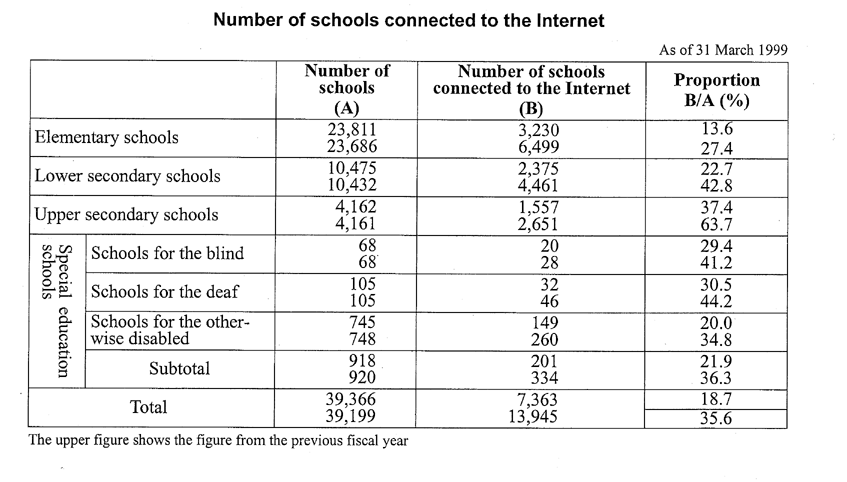| Home > Policy > White Paper, Notice, Announcement > White Paper > Japanese Government Policies in Education, Science, Sports and Culture1999 > Part2 Q58 | ||
A:We will promote active use of the Internetduring classes and foster the ability to use itappropriately.To this end,we are aiming toconnect all schools to the Internet by2001.
The information society has a light side and a dark side.There is much information on the Internet that is useful for education,while there is not a little information that may have a nega-tive influence on children.In addition,when sending information,it is important to adhere to manners and rules concerning privacy and copy-right.The new Courses of Study make an Informa-tion subject compulsory in lower and upper sec-ondary school and will ensure a thorough edu-cation on the influence of informatization on society and life and the importance of"informa-tion morals."In addition,in Periods for Integrated Study and the learning activities using the Internet for each course,students will learn to select what is essential for themselves out of the mass of in-formation,and develop the skills to construct their own ideas independently.An increasing number of schools are estab-lishing a"Guide to Internet Usage for Students"with rules such as"Respect Internet etiquette"and"It is forbidden to use pictures and photo-graphs produced by others without their con-sent."In future,there will be more and more op-portunities to use the Internet at school.To this end,the Ministry of Education,Sci-ence,Sports and Culture(MESSC)is promoting systematic plans to enable Internet use at schools by2001,and the current connection of schools to the Internet is shown in the following table.In addition,we have requested schools to develop effective applications for the education network with broadcasting satellites and fiber optic ca-bles which can transmit and receive high-speed,high-volume data,and we are working toward promoting this area.

Various organizations are running projects that support Internet usage in schools.These provide expertise and information exchange for when a school introduces the Internet,cooperative research and databases for each subject.The main ones at present are as below. National Education Center(http://www.naec.go.jp/)The National Education Center provides educational information,such as on distinctive teach-ing practices and measures to address bullying,implements training courses for information teachers,a software library and provides assistance in acquiring an education(ED)domain name. E-Square(e2 )Project(http:www.edu.ipa.go.jp/E-square/)The E-Square(e2 )Project carries out joint study projects,such as the Acid Rain/Nitrogen Oxide(NoX)Survey and the National Germination Map,promotes exchanges between schools and provides a range of information through its homepage(FY1994-FY1998100School Network-ing Project and the New100Schools Networking Project[Phase II]). Konet Plan(http://www.wnn.or.jp/wnn-s/)The Konet Plan conducts joint study projects such as the Marsville Project-Joint Japan-US Studies on Mars and the International Environment Survey Project,seminars via television con-ferencing and training sessions for teachers,through its homepage"Konet World." Japan Association for Promotion of Educational Technology(JAPET)(http://www.japet.or.jp)JAPET has been commissioned by MESSC to produce the Guide to Internet Usage for Teachers and Practical Ideas for Educational Computing which give ideas on how to use computers in the classroom. |
| Back to Top | MEXT HOME |